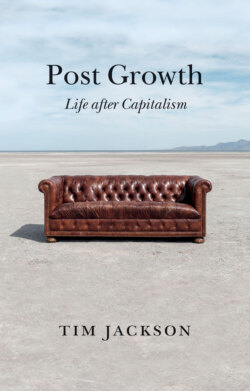Читать книгу Post Growth - Tim Jackson - Страница 25
A little more macroeconomics
ОглавлениеSurprisingly, perhaps, there’s a key element within capitalism which can help to tame this conflict. It flows from the concept of labour productivity: the efficiency with which an hour worked produces a dollar of output. Since labour is a cost to production and capitalists are motivated by profit, they will tend to do whatever they can to increase labour productivity: that is, to reduce the cost of labour. The profit motive provides an in-built incentive towards labour productivity growth.
To the extent that this drive is successful, the resulting cost savings can be distributed in various directions. Some of the benefits might go to workers, through increased pay or through shorter working hours. Some could go to shareholders in the form of higher dividends. Some might be passed on to consumers in the form of lower costs for the product. Some can be used to finance investments in new technologies which further increase labour productivity in the future.
When labour productivity is increasing, all of these things are possible. Workers can be paid more. Consumers can have cheaper goods. Shareholders can enjoy more profit. And the company can afford to invest in the next generation of labour-saving technology, creating a kind of virtuous circle of continuous improvement – and continuous growth. This virtuous circle is the solution to Rosa Luxemburg’s dilemma. The increase in wages is what allows for the expansion of profit. Labour productivity growth affords capitalism its biggest claim to legitimacy in the pursuit of social progress. But this inevitably only happens through growth.
When labour productivity growth stagnates, the profit motive begins to operate in a less benevolent way. The relative wage bill rises. Profit margins are squeezed. Wages, dividends, consumer prices and investment all come into competition with another. The potential for conflict between workers and investors intensifies. So does the tension between the present (consumption) and the future (investment). These too are the conditions that lead to the aggressive expansionism that Luxemburg feared.
I’m simplifying here. But this cursory understanding begins to make sense of the dysfunctional patterns of the last few decades. Behind all that we’ve been looking at lies the steady decline in the rate of growth of labour productivity, stemming from roughly half a century ago. The reasons for this decline are contested. Some regard it as the result of a slowing down – or a change in the structure – of consumer demand in the advanced nations. Others point to technological factors that put the brake on supply.30
There is a disturbing possibility that the huge productivity increases that characterized the early and middle twentieth century were a one-off, something we can’t just repeat at will, despite the wonders of digital technology. A fascinating – if worrying – contention is that the peak growth rates of the 1960s were only possible at all on the back of a huge and deeply destructive exploitation of dirty fossil fuels; something that can be ill afforded – even if it were available – in the era of dangerous climate change and declining resource quality.31
The critical question is how policy should respond to this not-so-new reality. Over the last few decades, capitalism has had a very specific response. Faced with diminishing returns, producers and shareholders have systematically protected profit by depressing the rewards to labour. Governments have encouraged this process through loose monetary policy, poor regulatory oversight and fiscal austerity. The outcome for many ordinary workers has been punitive. As social conditions deteriorated, the threat to democratic stability intensified.
The most prevalent ‘rescue narrative’ relies on the assumption that productivity growth will recover, primarily through new technological breakthroughs. Candidate ‘saviours’ in these rescue narratives are various. For some, innovation will arrive from investment in the same clean, low-carbon technologies that are needed to tackle climate change and offset resource depletion. For others, innovation will come from a new digital revolution: increased automation, robotization, artificial intelligence.
We’ll come back to these narratives later in the book. Each of them has important lessons for us. But for now, we’re thrown back to the question of this chapter with an uncomfortable set of answers. If there is a single culprit responsible for the demise of capitalism, it is beginning to look more and more as though it’s capitalism itself. At the very least, we must conclude that capitalism’s inherent pursuit of growth, when growth itself was elusive, has legitimized a succession of policies which have proved nothing short of disastrous – for people, for the planet and even for the economy itself.
